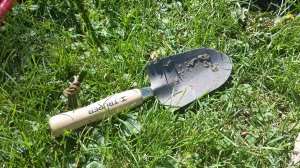Yet another week has gone by, and yet again we are just a little over a week away from the Fall season officially kicking in. I don’t know about you, but the transition from Summer to Fall is far more distinct to me than any of the other seasonal changeovers. As ironic as it is, Fall settles in, for some reason, I always think it’s time for me to start thinking of changing things up, setting new goals, starting fresh in life. The can also be said for one’s garden. Another growing season has yet passed, and I am anxious to begin work on next’s year’s garden! You don’t need a lot of tools at first.
A shovel and a few basics will help you with planting and transplanting in your garden:
- Trowel– the namesake of this blog. This is a small digging tool that works best when you are putting in flowers or plants in a bed that is already established. I often use the trowel to put any annuals or small perennials I plant.
2. Cultivator– is yet another hand tool with three prongs that is used to loosen the earth if the soil you are intending on planting in needs to to turned up to allow for planting. Cultivators come in many sizes, but the hand cultivator is the best suitable for small planting bed jobs.
3. Garden Hoe– a larger, but bigger cultivating tool that allows you to turn up the soil in your flowers beds that is used to get rid of any stray weeds that might be making their way into the garden. Very simple, and has been used for centuries as a type of cultivator.
And, if you are like me, you also like to make new beds, so digging into a part of your yard “cold turkey” calls for something much bigger and sturdier to get the job done. And of course, that is your basic shovel. Shovels are great for planting small trees, woody shrubs, and just planting anything in a place in your yard that has not been turned up and prepared for planting.
If you plan on doing some major landscaping, I recommend getting a tiller— which is more or less a gas powered cultivator that can turn up a vast amount of area in a relatively small amount of time. Small versions of a tiller start at around $250. But usually you are well into being an established gardener when you decide to purchase one of these. You can also rent one if you don’t have that type of cash to spend on lawn equipment.
It may take a few growing seasons before you understand the reasoning behind transplanting. Maybe the garden you started has a few things that aren’t growing to their fullest potential in one area, so you are going to try another spot to see if they do better. Or, you are focusing on garden aesthetics and realize that you don’t like your clematis right next to a new lilac. These are just a few examples of what transplanting can do. Transplanting transforms the look of your landscape, and is important in creating harmony for you and your growing space.


